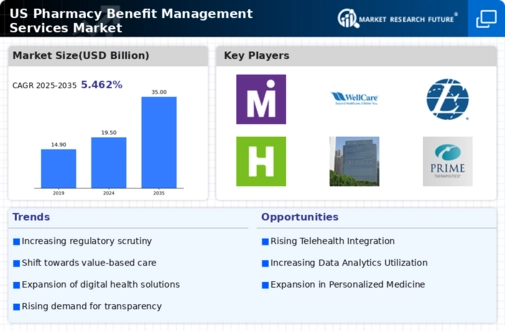Rising Prescription Drug Costs
The escalating costs of prescription drugs in the US are a primary driver for the pharmacy benefit-management-services market. As drug prices continue to rise, employers and health plans seek effective management solutions to control these expenses. Reports indicate that prescription drug spending has increased by approximately 10% annually, prompting organizations to turn to pharmacy benefit managers (PBMs) for cost-effective strategies. The pharmacy benefit-management-services market is thus positioned to grow as stakeholders demand innovative solutions to mitigate these rising costs. This trend is likely to persist, as the need for cost containment becomes increasingly critical in the healthcare landscape.
Shift Towards Value-Based Care
The transition from fee-for-service to value-based care models is significantly influencing the pharmacy benefit-management-services market. This shift emphasizes patient outcomes and cost-effectiveness, compelling PBMs to adapt their services accordingly. As healthcare providers focus on delivering high-quality care, the demand for pharmacy benefit-management services that align with these goals is expected to increase. The market is projected to expand as PBMs develop programs that incentivize the use of cost-effective medications and therapies. This alignment with value-based care not only enhances patient outcomes but also supports the financial sustainability of healthcare systems.
Consumer-Centric Healthcare Trends
The pharmacy benefit-management-services market is experiencing a shift towards more consumer-centric healthcare approaches. Patients are becoming more engaged in their healthcare decisions, seeking transparency and affordability in their medication options. This trend is prompting PBMs to enhance their services, offering tools that empower consumers to make informed choices about their prescriptions. As a result, the market is likely to see an increase in demand for services that facilitate price comparisons, medication adherence programs, and personalized care solutions. This consumer-driven approach not only improves patient satisfaction but also aligns with broader healthcare reform initiatives.
Increased Demand for Specialty Drugs
The growing prevalence of chronic diseases and complex health conditions has led to a surge in the demand for specialty drugs, which are often high-cost medications. This trend is a significant driver for the pharmacy benefit-management-services market, as PBMs play a crucial role in managing the utilization and costs associated with these therapies. Specialty drug spending is anticipated to account for over 50% of total drug expenditures in the coming years. Consequently, pharmacy benefit managers are increasingly tasked with developing strategies to ensure appropriate access while controlling costs, thereby enhancing their relevance in the healthcare ecosystem.
Technological Advancements in Pharmacy Management
Technological innovations are reshaping the pharmacy benefit-management-services market, driving efficiency and improving service delivery. The integration of advanced data analytics, artificial intelligence, and telehealth solutions is enabling PBMs to optimize their operations and enhance patient care. These technologies facilitate better medication management, adherence tracking, and personalized treatment plans. As the healthcare industry continues to embrace digital transformation, the pharmacy benefit-management-services market is expected to grow, with PBMs leveraging technology to streamline processes and improve outcomes. This trend underscores the importance of innovation in maintaining competitiveness within the market.

























Leave a Comment